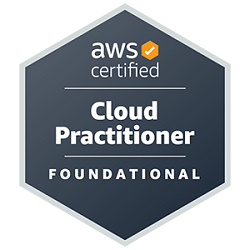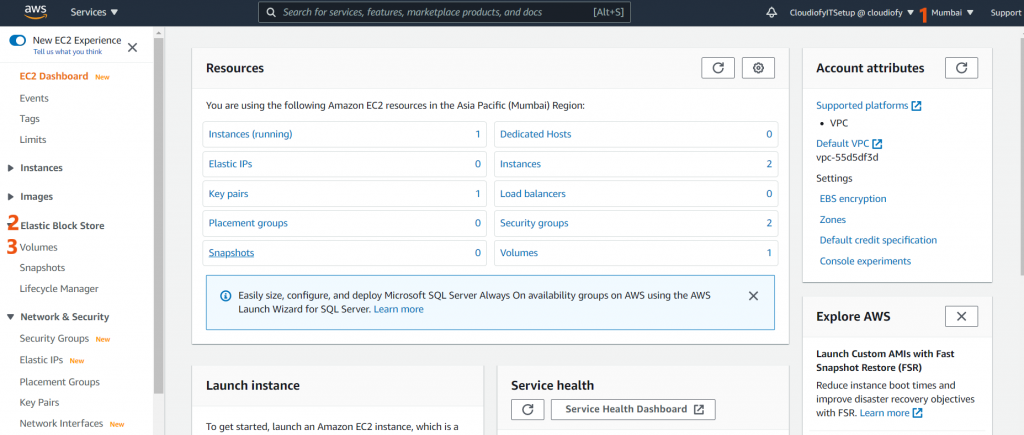Obiettivi | Certificazione | Contenuti | Tipologia | Prerequisiti | Durata e Frequenza | Docenti | Modalità di Iscrizione | Calendario

Il Corso AWS Cloud Practitioner Essentials (ACPEXX) è stato progettato per i partecipanti che desiderano acquisire una conoscenza fondamentale del cloud computing di Amazon Web Services (AWS) e delle sue funzionalità e servizi. Durante il corso, i partecipanti apprenderanno i concetti di base del cloud computing, i modelli di servizio e di distribuzione del cloud, la sicurezza e la conformità, la gestione degli account e molto altro. Inoltre, il corso copre i servizi di AWS, tra cui l’archiviazione, l’elaborazione, le reti, la sicurezza, il machine learning e molto altro. Il corso contribuisce alla preparazione della Certificazione AWS Certified Cloud Practitioner.
Sintesi Statistica
- Corsi realizzati: 28
- Numero Corsisti: 312
- Superamento Esame: 96,35%
Contattaci ora per ricevere tutti i dettagli e per richiedere, senza alcun impegno, di parlare direttamente con uno dei nostri Docenti (Clicca qui)
oppure chiamaci subito al nostro Numero Verde (800-177596)
Obiettivi del corso
Di seguito una sintesi degli obiettivi principali del corso Corso AWS Cloud Practitioner Essentials (ACPEXX):
- Acquisire una conoscenza fondamentale del cloud computing di Amazon Web Services (AWS) e delle sue funzionalità e servizi.
- Apprendere i concetti di base del cloud computing.
- Conoscere i modelli di servizio e di distribuzione del cloud.
- Comprendere la sicurezza e la conformità nel contesto di AWS.
- Familiarizzare con i servizi di AWS, tra cui l’archiviazione, l’elaborazione, le reti e la sicurezza.
Certificazione del corso
Esame AWS Certified Cloud Practitioner; L’esame di certificazione AWS Certified Cloud Practitioner (CLF-C02) ha come obiettivo di valutare la conoscenza dei candidati sui principali concetti e servizi relativi al cloud computing su AWS. Gli esaminati devono dimostrare di avere una comprensione generale dei servizi cloud di AWS, delle best practice di sicurezza, dell’architettura di base e delle opzioni di supporto offerte da AWS.
Contenuti del corso
Module 1: Introduction to Amazon Web Services
- Summarize the benefits of AWS
- Describe differences between on-demand delivery and cloud deployments
- Summarize the pay-as-you-go pricing model
Module 2: Compute in the Cloud
- Describe the benefits of Amazon Elastic Compute Cloud (Amazon EC2) at a basic level
- Identify the different Amazon EC2 instance types
- Differentiate between the various billing options for Amazon EC2
- Describe the benefits of Amazon EC2 Auto Scaling
- Summarize the benefits of Elastic Load Balancing
- Give an example of the uses for Elastic Load Balancing
- Summarize the differences between Amazon Simple Notification Service (Amazon SNS) and Amazon Simple Queue Services (Amazon SQS)
- Summarize additional AWS compute options
Module 3: Global Infrastructure and Reliability
- Summarize the benefits of the AWS Global Infrastructure
- Describe the basic concept of Availability Zones
- Describe the benefits of Amazon CloudFront and Edge locations
- Compare different methods for provisioning AWS services
Module 4: Networking
- Describe the basic concepts of networking
- Describe the difference between public and private networking resources
- Explain a virtual private gateway using a real life scenario
- Explain a virtual private network (VPN) using a real life scenario
- Describe the benefit of AWS Direct Connect
- Describe the benefit of hybrid deployments
- Describe the layers of security used in an IT strategy
- Describe which services are used to interact with the AWS global network
Module 5: Storage and Databases
- Summarize the basic concept of storage and databases
- Describe benefits of Amazon Elastic Block Store (Amazon EBS)
- Describe benefits of Amazon Simple Storage Service (Amazon S3)
- Describe the benefits of Amazon Elastic File System (Amazon EFS)
- Summarize various storage solutions
- Describe the benefits of Amazon Relational Database Service (Amazon RDS)
- Describe the benefits of Amazon DynamoDB
- Summarize various database services
Module 6: Security
- Explain the benefits of the shared responsibility model
- Describe multi-factor authentication (MFA)
- Differentiate between the AWS Identity and Access Management (IAM) security levels
- Describe security policies at a basic level
- Explain the benefits of AWS Organizations
- Summarize the benefits of compliance with AWS
- Explain primary AWS security services at a basic level
Module 7: Monitoring and Analytics
- Summarize approaches to monitoring your AWS environment
- Describe the benefits of Amazon CloudWatch
- Describe the benefits of AWS CloudTrail
- Describe the benefits of AWS Trusted Advisor
Module 8: Pricing and Support
- Understand AWS pricing and support models
- Describe the AWS Free Tier
- Describe key benefits of AWS Organizations and consolidated billing
- Explain the benefits of AWS Budgets
- Explain the benefits of AWS Cost Explorer
- Explain the primary benefits of the AWS Pricing Calculator
- Distinguish between the various AWS Support Plans
- Describe the benefits of AWS Marketplace
Module 9: Migration and Innovation
- Understand migration and innovation in the AWS Cloud
- Summarize the AWS Cloud Adoption Framework (AWS CAF)
- Summarize six key factors of a cloud migration strategy
- Describe the benefits of various AWS data migration solutions, such as AWS Snowcone, AWS Snowball, and AWS Snowmobile
- Summarize the broad scope of innovative solutions that AWS offers
- Summarize the five pillars of the AWS Well-Architected Framework
Module 10: AWS Certified Cloud Practitioner Basics
- Determine resources for preparing for the AWS Certified Cloud Practitioner examination
- Describe benefits of becoming AWS Certified
Tipologia
Corso di Formazione con Docente
Docenti
I docenti sono Istruttori accreditati Amazon AWS e certificati in altre tecnologie IT, con anni di esperienza pratica nel settore e nella Formazione.
Infrastruttura laboratoriale
Per tutte le tipologie di erogazione, il Corsista può accedere alle attrezzature e ai sistemi presenti nei Nostri laboratori o direttamente presso i data center del Vendor o dei suoi provider autorizzati in modalità remota h24. Ogni partecipante dispone di un accesso per implementare le varie configurazioni avendo così un riscontro pratico e immediato della teoria affrontata. Ecco di seguito alcuni scenari tratti dalle attività laboratoriali:

Dettagli del corso
Prerequisiti
Non ci sono prerequisiti.
Durata del corso
Durata Intensiva 1gg.
Frequenza
Varie tipologie di Frequenza Estensiva ed Intensiva.
Date del corso
- AWS Cloud Practitioner Essentials (Formula Intensiva) – 13/05/2024 – 9:00 – 17:00
- AWS Cloud Practitioner Essentials (Formula Intensiva) – 10/06/2024 – 9:00 – 17:00
- AWS Cloud Practitioner Essentials (Formula Intensiva) – 08/07/2024 – 9:00 – 17:00
- AWS Cloud Practitioner Essentials (Formula Intensiva) – 09/09/2024 – 9:00 – 17:00
- AWS Cloud Practitioner Essentials (Formula Intensiva) – 07/10/2024 – 9:00 – 17:00
- AWS Cloud Practitioner Essentials (Formula Intensiva) – 11/11/2024 – 9:00 – 17:00
- AWS Cloud Practitioner Essentials (Formula Intensiva) – 09/12/2024 – 9:00 – 17:00
Modalità di iscrizione
Le iscrizioni sono a numero chiuso per garantire ai tutti i partecipanti un servizio eccellente. L’iscrizione avviene richiedendo di essere contattati dal seguente Link, o contattando la sede al numero verde 800-177596 o inviando una richiesta all’email [email protected].


